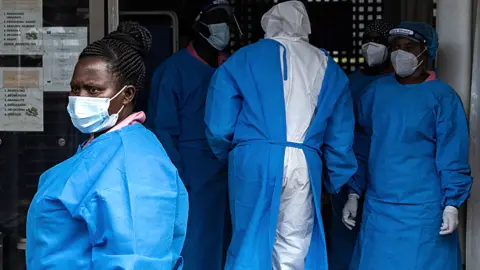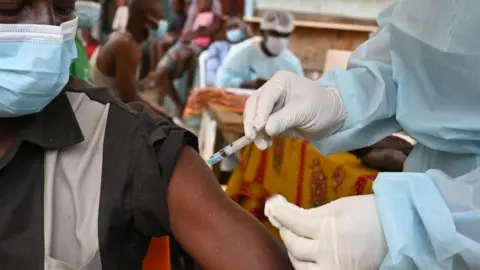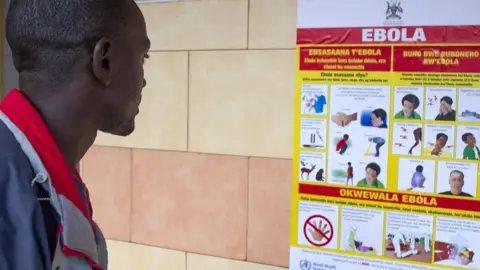What is Ebola and why is Uganda's outbreak so serious?
 AFP
AFPAn outbreak of Ebola in Uganda is proving more difficult to deal with than more recent epidemics, with its recent spread to the capital city, Kampala, causing particular concern.
So far 75 cases have been confirmed in four provinces, though it is feared that there could be many more which were not detected before the victims were buried.
What is Ebola?
It is a deadly virus with initial symptoms which can include a sudden fever, intense weakness, muscle pain and a sore throat.
Subsequent stages can include vomiting, diarrhoea and - in some cases - both internal and external bleeding, known as haemorrhaging.
The incubation period can last from two days to three weeks. Symptoms of Ebola can sometimes be confused with other illnesses such as malaria and typhoid.
Why is this outbreak so serious?
The virus has been circulating in rural parts of Uganda since September but an outbreak in an urban area - like Kampala - is much more complex to deal with.
The population density and ease of mobility, including internationally, means the virus can easily travel through an infected but asymptomatic patient within a short period of time.
However an asymptomatic person cannot transmit the virus. Speed is of the essence when tracing contacts of known cases, isolating and monitoring them for at least the 21-day incubation period of the virus.
The cooperation of such contacts with response teams is also crucial. The infection in Kampala has been traced to a contact of a confirmed case who reportedly travelled to the capital under a disguised identity.
He tried to seek help from a traditional healer before turning to a hospital where he was admitted, but later succumbed to the illness.
Seven members of one family he had come into contact with got infected.
Ebola spreads between humans by direct contact with bodily fluids and contaminated items or environments. Funerals can be a particular risk if mourners have direct contact with the body.
The Health Ministry says there were 18 deaths, linked to confirmed cases, where the bodies were buried before they could be tested.
There is a discrepancy between the numbers of deaths given by Uganda's government and WHO figures, because the latter is counting the 18 probable Ebola deaths, whereas Kampala is only including deaths where Ebola has been confirmed.
The World Health Organization (WHO) estimates the fatality rate is between 41% and 100%.
Is there a vaccine?
Another concern is that this is the Sudan strain of Ebola, for which there is no approved vaccine, unlike the more common Zaire strain.
The Health Ministry has said three candidate vaccines from Oxford, Sabin and Merck will be trialled for efficacy "in coming weeks". Several treatment options are also being tested, said Health Minister Jane Ruth Aceng.
 Getty Images
Getty ImagesThe Zaire strain was responsible for the largest ever outbreak of Ebola, in West Africa from December 2013 to 2016. More than 11,000 people died.
With more than 28,000 cases in Guinea, Liberia and Sierra Leone, scientists carried out intensive research into Ebola vaccines.
Two years after that epidemic ended, the then unlicensed Ervebo vaccine, developed by Merck, was used during an outbreak of the Zaire strain in the west of the Democratic Republic of Congo.
It was granted clearance by the WHO, which said it had limited infections and saved lives.
A second vaccine by Johnson & Johnson has since been approved for use by the European Medicines Agency.
But neither of these vaccines has been tested against the Sudan strain.
Nonetheless Uganda's President Yoweri Museveni had previously said his government was exploring whether it was worth trying them.
How is Uganda dealing with the outbreak?
The focus is on contact tracing - finding those who have been in close proximity with patients, especially those who attended the community funerals.
Treatment and isolation facilities have been set up in the affected districts. Their capacity is being ramped up as the virus spreads.
Mobile laboratories were also deployed, so that people would not have to travel for tests and risk spreading the virus.
Medics have expressed concern about the lack of adequate personal protective equipment (PPE) such as gloves and masks. They have also called for stricter measures including more lockdowns of areas with confirmed cases.
President Museveni initially ruled out such restrictions, saying: "Ebola is not spread like corona[virus]" as it is not an airborne disease.
He said markets, schools and places of worship would remain open, but urged people to observe personal hygiene and avoid close contact.
The government later relented and placed the two districts at the centre of the outbreak under lockdown.
"We believe transmission may have been disrupted," said the Health Ministry as there had been no secondary cases of infection since the lockdown. However, no such restrictions have been imposed in Kampala.
How does Ebola spread?
Ebola jumps to humans from infected animals, such as chimpanzees, fruit bats and forest antelope.
Bushmeat - wild forest animals hunted for human consumption - is thought to be the natural reservoir of the virus.
It then spreads between humans by direct contact with contaminated bodily fluids - blood, saliva, vomit, semen, vaginal discharge, urine, faeces and sweat.
Men who have recovered from Ebola have also been found to harbour the virus in their semen for a period after recovery.
What precautions can be taken?
To prevent infection, health professionals advise avoiding contact with cases, including stopping shaking hands, washing hands with soap and water and cleaning surfaces with chlorinated water.
It is also important to isolate cases and their contacts. Countries usually set up holding centres for suspected cases and treatment centres for laboratory-confirmed cases.
 EPA
EPAIn eastern DR Congo, which borders Uganda, survivors of Ebola played a key role in providing care for infected patients as it has been established that they cannot be re-infected.
However, medical teams must wear full PPE when attending to cases to prevent infection.
Bodies, in a body bag, must be buried by those wearing proper PPE. More recent innovations have included having body bags with clear covers around the face to enable families to view the body safely before burial.
